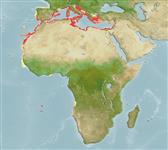Environment: milieu / climate zone / depth range / distribution range
Ökologie
seewasser demersal; tiefenbereich 1 - 100 m (Ref. 2683). Subtropical; 45°N - 18°S, 19°W - 36°E
Eastern Atlantic: Portugal to Angola. Also known from the Mediterranean.
Size / Gewicht / Alter
Maturity: Lm ? range ? - ? cm
Max length : 45.0 cm SL Männchen/unbestimmt; (Ref. 6790); common length : 30.0 cm SL Männchen/unbestimmt; (Ref. 4675)
Inhabit shallow waters to about 100 m depth, burrowing in the bottom. Feed on small fishes and crustaceans (Ref. 3697). Anterolateral glandular grooves and opercular spine with venom gland (Ref. 57406). Oviparous, eggs and larvae are pelagic (Ref. 4675).
Life cycle and mating behavior
Geschlechtsreife | Fortpflanzung | Ablaichen | Eier | Fecundity | Larven
Roux, C., 1990. Trachinidae. p. 893-895. In J.C. Quero, J.C. Hureau, C. Karrer, A. Post and L. Saldanha (eds.) Check-list of the fishes of the eastern tropical Atlantic (CLOFETA). JNICT, Lisbon; SEI, Paris; and UNESCO, Paris. Vol. 2. (Ref. 6790)
IUCN Rote Liste Status (Ref. 130435)
Nutzung durch Menschen
Fischereien: weniger kommerziell
Mehr Information
NamenSynonymeMetabolismusRäuberÖkotoxikologieFortpflanzungGeschlechtsreifeAblaichenSpawning aggregationFecundityEierEientwicklung
ReferenzenAquakulturAquakultur ProfilZuchtlinienGenetikElectrophoresesVererbbarkeitKrankheitenVerarbeitungNutrientsMass conversion
PartnerBilderStamps, Coins Misc.LauteCiguateraGeschwindigkeitSchwimmstilKiemenoberflächeOtolithsGehirngrößeSehfähigkeit
Tools
Zusatzinformationen
Download XML
Internet Quellen
Estimates based on models
Preferred temperature (Ref.
123201): 14.7 - 21.5, mean 18.6 °C (based on 274 cells).
Phylogenetic diversity index (Ref.
82804): PD
50 = 0.5059 [Uniqueness, from 0.5 = low to 2.0 = high].
Bayesian length-weight: a=0.01047 (0.00509 - 0.02156), b=2.92 (2.74 - 3.10), in cm total length, based on LWR estimates for this species & (Sub)family-body (Ref.
93245).
Trophic level (Ref.
69278): 4.0 ±0.66 se; based on food items.
Widerstandsfähigkeit (Ref.
120179): niedrig, Verdopplung der Population dauert 4,5 - 14 Jahre. (Preliminary K or Fecundity.).
Fishing Vulnerability (Ref.
59153): Moderate vulnerability (42 of 100).
Nutrients (Ref.
124155): Calcium = 64 [40, 118] mg/100g; Iron = 0.913 [0.588, 1.432] mg/100g; Protein = 19.1 [18.3, 19.9] %; Omega3 = 0.362 [0.252, 0.528] g/100g; Selenium = 25.2 [13.6, 48.0] μg/100g; VitaminA = 16.7 [6.0, 48.2] μg/100g; Zinc = 0.731 [0.549, 1.015] mg/100g (wet weight);
